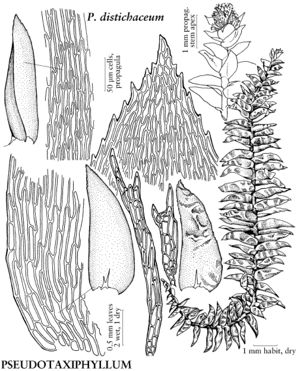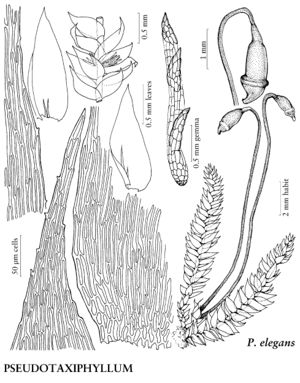Pseudotaxiphyllum
J. Hattori Bot. Lab. 63: 448, figs. 1e–h, 2c,d. 1987.
| Taxon | Illustrator ⠉ | |
|---|---|---|
 | Pseudotaxiphyllum distichaceum | Patricia M. Eckel |
 | Pseudotaxiphyllum elegans | Patricia M. Eckel |
Plants medium-sized, in thin to dense mats, dark or light green to yellowish, glossy. Stems creeping, simple or sparingly and irregularly branched; hyalodermis absent, central strand sometimes present; pseudoparaphyllia absent. Stem and branch leaves similar, erect-spreading to squarrose, lanceolate, ovatelanceolate, or oblong-lanceolate, widest beyond base, smooth or undulate, not plicate; base not decurrent; margins plane or narrowly recurved basally, serrate to entire; apex acute to acuminate; costa double and short or ecostate; alar cells not differentiated or quadrate to short-rectangular; laminal cells smooth or distal cells sometimes prorulose at distal ends on abaxial surface; distal cells usually longer than 6: 1. Specialized asexual reproduction by multicellular bodies sometimes present in clusters at stem apices or below in leaf-axils. Sexual condition dioicous or autoicous, usually sterile; perichaetial leaves small, lanceolate to ovate, apex acuminate to abruptly filiform-acuminate. Seta yellow, red, reddish-brown, or dark red. Capsule erect to pendulous, ellipsoid to ovoid, straight to subarcuate, contracted below mouth and wrinkled at neck when dry; annulus 2-seriate or 3-seriate, deciduous; operculum conic to short-rostrate; peristome double; exostome teeth with external surface cross-striolate proximally, papillose distally; endostome basal membrane high to low, segments keeled, cilia shorter than segments, in groups of 1–3. Calyptra naked. Spores spheric to ovoid, minutely papillose.
Distribution
North America, Mexico, West Indies, Central America, South America, Europe, Asia, Africa
Discussion
Species 10 (3 in the flora).
Pseudotaxiphyllum occurs in terrestrial habitats in temperate, subtropical, and tropical regions. The stems have small, thick-walled cortical cells; the smooth rhizoids arise in clusters below the leaf insertions. Perigonia are found along the stems, and perichaetia at the base; the setae are twisted; the capsules are dark brown to dark red and sometimes wrinkled; and the exostome teeth are bordered and internally trabeculate.
Selected References
None.
Lower Taxa
Key
| 1 | Leaves upturned-homomallous; medial laminal cells 5-9 µm wide; propagula absent. | Pseudotaxiphyllum homomallifolium |
| 1 | Leaves not upturned-homomallous; medial laminal cells 4-7 µm wide; propagula present | > 2 |
| 2 | Leaves asymmetric, cultriform; propagula clustered in leaf axils at or near stem apices, twisted-vermiform, with 1-5 acute teeth at apices. | Pseudotaxiphyllum distichaceum |
| 2 | Leaves symmetric; propagula clustered in leaf axils below stem apices, not twisted-vermiform, resembling parent plant only smaller, bearing reduced leaves from apex to base of propagula. | Pseudotaxiphyllum elegans |